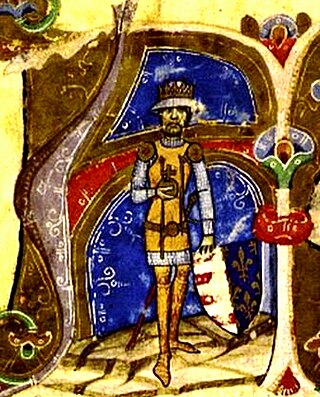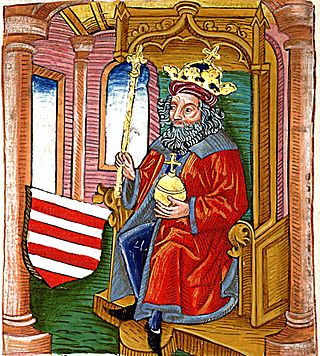
Charles I, also known as Charles Robert, was King of Hungary and Croatia from 1308 to his death. He was a member of the Capetian House of Anjou and the only son of Charles Martel, Prince of Salerno. His father was the eldest son of Charles II of Naples and Mary of Hungary. Mary laid claim to Hungary after her brother, Ladislaus IV of Hungary, died in 1290, but the Hungarian prelates and lords elected her cousin, Andrew III, king. Instead of abandoning her claim to Hungary, she transferred it to her son, Charles Martel, and after his death in 1295, to her grandson, Charles. On the other hand, her husband, Charles II of Naples, made their third son, Robert, heir to the Kingdom of Naples, thus disinheriting Charles.

Wenceslaus III was King of Hungary and Croatia between 1301 and 1305, and King of Bohemia and Poland from 1305. He was the son of Wenceslaus II, King of Bohemia, who was later also crowned king of Poland, and Judith of Habsburg. Still a child, Wenceslaus was betrothed to Elizabeth, the sole daughter of Andrew III of Hungary. After Andrew III's death in early 1301, the majority of the Hungarian lords and prelates elected Wenceslaus king, although Pope Boniface VIII supported another claimant, Charles Robert, a member of the royal house of the Kingdom of Naples.

The Turul is a mythological bird of prey, mostly depicted as a falcon, in Hungarian tradition and Turkic tradition, and a national symbol of Hungarians.
Máté Csák or Matthew III Csák, also Máté Csák of Trencsén, was a Hungarian oligarch who ruled de facto independently the north-western counties of Medieval Hungary. He held the offices of master of the horse (főlovászmester) (1293–1296), palatine (nádor) and master of the treasury (tárnokmester) (1309–1311). He was able to maintain his rule over his territories even after his defeat at the Battle of Rozgony against King Charles I of Hungary. In the 19th century, he was often described as a symbol of the struggle for independence in both the Hungarian and Slovak literatures.

Abaúj is a historic administrative county (comitatus) of the Kingdom of Hungary. In parts of the 19th century, and in the beginning of the 20th century, it was united with Torna County to form Abaúj-Torna county. Its territory is now in eastern Slovakia and north-eastern Hungary. Today Abaúj and Abov are only informal designations of the corresponding territories in Hungary and Slovakia.

The Chronicon Pictum or Illuminated Chronicle is a medieval illustrated chronicle from the Kingdom of Hungary from the 14th century. It represents the artistic style of the royal court of King Louis I of Hungary. The codex is a unique source of art, medieval and cultural history.

The Gesta Hunnorum et Hungarorum is a medieval chronicle written mainly by Simon of Kéza around 1282–1285. It is one of the sources of early Hungarian history. It is also known as the Gesta Hungarorum (II), the "(II)" indicating its status as an expansion of the original Gesta Hungarorum.

The Buda Chronicle is a 15th-century chronicle treating the early and medieval Hungarian history. While its original name is Chronica Hungarorum, the chronicle is better known as the "Buda Chronicle" since the 19th century. Its text is eponymous part of the so-called Buda Chronicle family. The Buda Chronicle was printed in the capital of the Kingdom of Hungary in Buda by András Hess in 1473, becoming the first book printed in Hungary. With printing, the Buda Chronicle was not forgotten for centuries long as its predecessor Hungarian medieval chronicles, which were in manuscript codices, however the content of the Buda Chronicle soon became obsolete due to the more extensive Hungarian history of the Thuróczy Chronicle, which was published in 1488, which also bears the same title "Chronica Hungarorum".

Otto III, a member of the Wittelsbach dynasty, was the Duke of Lower Bavaria from 1290 to 1312 and the King of Hungary and Croatia between 1305 and 1307. His reign in Hungary was disputed by Charles Robert of the Angevin dynasty.

Abaújvár is a village in northeastern Hungary, next to the Slovak border. It lies 72 km (45 mi) northeast of Miskolc, and 18 km south of Košice (Kassa), Slovakia.
Rozhanovce is a village in Košice-okolie District of eastern Slovakia. It is situated about 20 kilometres (12 mi) far from the city of Košice.

In Hungarian mythology, Prince Csaba was the youngest son of Attila, King of the Huns. A fierce and skilled warrior, he led the Huns to victory in all the battles they encountered over the ages. He is the legendary leader of the Székelys.

Amadeus Aba or Amade Aba was a Hungarian oligarch in the Kingdom of Hungary who ruled de facto independently the northern and north-eastern counties of the kingdom. He held the office of Palatine several times, and he was also judge royal twice. He was assassinated at the south gate in the city of Kassa by Saxon burghers.
Mieszko Bolesławowic was the only son of Bolesław II the Generous, King of Poland. Mieszko was Prince of Kraków from 1086 until his death in 1089.
Thomas (I) Szécsényi was a Hungarian powerful baron and soldier, who rose to prominence during King Charles I's war against the oligarchs. He belonged to the so-called "new aristocracy", who supported the king's efforts to restore royal power in the first decades of the 14th century. He was the first member of the influential Szécsényi family.

Thomas was a prelate in the Kingdom of Hungary in the first half of the 14th century. He was Archbishop of Esztergom between 1305 and 1321. He was a confidant of Charles I of Hungary, whom he has supported in his unification war against the provincial lords. He crowned Charles twice, in June 1309 and August 1310.
Julius from the kindred Básztély was a Hungarian noble at the turn of the 13th and 14th centuries.
Kakas from the kindred Rátót was a Hungarian nobleman and soldier at the turn of the 13th and 14th centuries, who served as Master of the horse in the court of pretender Wenceslaus during the era of Interregnum. Alongside his kinship, he joined Charles I later. He perished in Battle of Rozgony. He was the forefather of the Kakas de Kaza noble family.
Sinka Sebesi, also known as Sinka, son of Thomas, was a Hungarian medieval soldier and nobleman at the turn of the 13th and 14th centuries. He distinguished himself in various royal campaigns since the reign of Andrew III of Hungary. He actively participated in the unification war of Charles I of Hungary against the oligarchic domains.
Aladar (I) Forrói was a Hungarian nobleman, whose career spanned from the second half of the 13th century to the early 14th century. He held various positions in the courts of several queen consorts for four decades.















